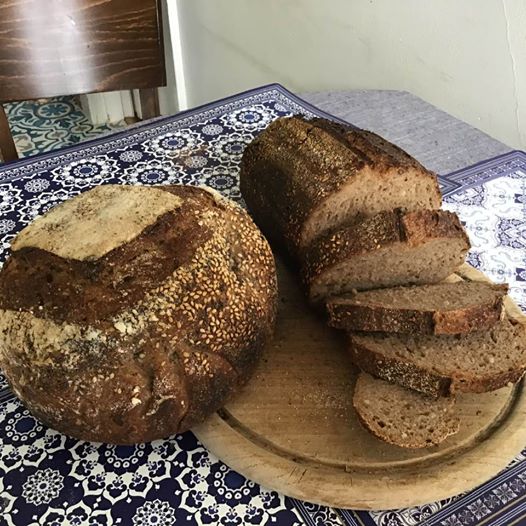
Sheltering at home has encouraged people to pick up various cooking projects, and I hear a lot about new sourdough enthusiasts! I may have even helped one or two of them bake their first loaf. I’ve been baking sourdough for some years now and it’s been a marvelous learning journey; with every loaf I learn more about the science and art of the process and gain more respect for wild yeast.
The loaf in the picture, which I baked this morning, is actually what started the whole thing. I used to be very sensitive to wheat, until I discovered that I can eat long-fermentation sourdough breads to no ill effect. I then developed an expensive habit: the amazing oatmeal porridge loaf from Tartine Bakery. It made me feel a bit like a chump to stand in line for a $12 loaf (!!!), and so I decided to learn to bake bread and be my own hero.
If you’d like to start, particularly if you dig the idea of whole grains and seeds, I would strongly recommend picking up Tartine Book No. 3. It has the Tartine recipe for a starter, the recipe for a basic white country loaf, and many variations on the theme, including breads with porridges and sprouted grains. While you get an easier rise out of bread that is at least in part made with white bread flour, the loaves above are 100% whole grain: 1000g hard white wheat (whole grain) and 250g steel cut oatmeal (leftover from breakfast) with 800g water and 25g salt.
Many of my fellow sourdough enthusiasts swear by Elaine “Foodbod” Boddy’s master sourdough recipe. It’s easy and beginner-friendly, and her gear list is great, though I think the instructions neglect to properly teach shaping (a crucially important skill to put some surface tension on the loaf so that it rises nicely.) Here’s the gear I use with some common household substitutes:
| Purpose | Gear I use and like | Solid substitutes |
| starter storage | nice handmade jar by Mark Campbell | any Tupperware. When you’re starting out, clear containers with a rubber band around them will help you see how much the starter’s risen) |
| flour storage | bins from The Container Store | any bin or bag. |
| dough mixing | any large kitchen bowl | professional bakeries use giant plastic bins. Anything really big you own will do. |
| cover | I have a couche, which is a bit heavier than a tea towel, and comes in handy if you ever want to make baguettes. | a tea towel will do just fine (that’s what I used in Cambridge.) |
| dough cutting | Even though I own a nice bench knife, I often just use my Cutco kitchen shears. | Kitchen shears will serve you well. You’ll notice that it is really hard and sticky to cut dough with a knife! |
| shaping | I use two well-floured cutting boards. | You can go fancy here and buy or make a baker’s bench. I don’t have one–a girl can dream! |
| storage | I use banneton baskets, which come in various sizes and shapes. I own a round one with a liner and an oblong one with a liner, both from Breadtopia. I put the full baskets in plastic bags to prevent the loaves from drying. | At Cambridge I simply used round kitchen bowls, and you can do the same, provided that you cover them with well-floured kitchen bowls. |
| inversion into baking vessel | parchment paper. | No substitutes here. I would not bake without it–it’s a nightmare to release a stuck loaf from a baking vessel–nor would I use wax paper, which is terrible and sticks to your bread. |
| scoring tool | bread lame and sharp razor blades | you can rig a nice lame from a razor blade and a cheap chopstick. |
| baking vessel | I bake my round loaves in a 3qt Cuisinart Dutch Oven and my long ones in a clay cloche from Breadtopia | You’ll need something that can withstand a 500F degree oven, and I’d recommend sticking to a 3-3.5qt size. This Lodge Combo Cooker, which I used when were were in Cambridge, is a great value. |
If this seems like a big to-do, at the beginning it kind of is, but it tends to settle into your weekly routine quite nicely. I bake once a week and find that the starter does most of the work for me. 🙂 There are a few hours where it’ll want about 30 seconds of your attention every half hour or so, but other than that, a lot of it is about patience.
If you find yourself looking for a new project to embark on, this might be a fun one for you! Let me know how it goes.



No comment yet, add your voice below!